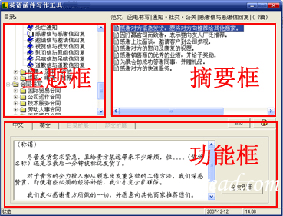经典案例七 Lexmark International
|
Organization, Teamwork, and Communication Facing Business Challenges At Lexmark International From IBM to Independence How do you build a new, independent organization after years of control by a gigantic, global parent? That was the challenge facing top executives at Lexmark International. The original factory in Lexington, Kentucky, was a division of IBM, manufacturing electric typewriters renowned for their durability and useful features. In later years, after IBM introduced the personal computer, the division also made keyboards and printers. Then IBM decided to get out of the typewriter and printer business. An investment firm bought the division in 1991, along with the right to use the IBM name on its products until 1996. The new company was called Lexmark, a combination of lex (derived from lexicon, a dictionary or a particular vocabulary) and mark (from the idea of making a mark on paper, like a printer). A 32-year veteran of IBM, Marvin L. Mann was appointed CEO. In turn, he recruited other IBM executives to head production, research and development, human resources, and sales and marketing. Together, they were responsible for planning the transition from operating as one of many IBM divisions to operating as an independent company making $1.8 billion in sales to customers all over the world. Lexmark started life with more than 5,000 employees but soon slimmed down to 4,100 by offering payouts to people who agreed to leave the company voluntarily. The company inherited a well-trained and motivated work force from parent IBM, and it shared IBM's commitment to high quality and strict ethical standards. However, Mann wanted some things at Lexmark to be different from the way they were under IBM. He was concerned that the new company would have a hard time putting creative ideas in motion if employees on the shop floor had to go through layers of management to talk with decision makers at the top. He also wanted to speed up decision making by avoiding the delays IBM experienced when managers from different departments challenged each other's proposals. Finally, he wanted Lexmark employees to risk trying new things without fearing that they would be punished for failures. Mann and his management team knew well that these changes wouldn't be easy¾altering the way employees work together and even modifying the way ideas flow upward and downward. If the new company was to thrive on its own, managers and employees alike would have to forget the IBM way and build an entirely new organization. How could Mann set up a structure that would unleash his employees' creativity and entrepreneurial spirit? In what way could he arrange work tasks to manufacture printers more efficiently? How could he streamline Lexmark to allow the company to respond quickly to changes in customer needs and shifts in competitive pressures? Meeting Business Challenges at Lexmark International Marvin Mann knew that Lexmark's move from IBM to independence would require an entirely new organization structure. Under the IBM system, eight layers of management had separated assembly-line workers from top managers, and employees had to approach manager after manager to get the necessary approvals for changes or new projects. In addition, coming up with new products took 2 or 3 years from the time an idea was proposed (say, for a new printer) until the first printer rolled off the assembly line. Meanwhile, aggressive competitors like Hewlett-Packard, Apple, Canon, and Epson were moving quickly to bring out new printers packed with clever features that customers desired. Mann started by reorganizing Lexmark according to product, creating four groups that each focused on a set of related products. Next, Mann cut the number of management layers from eight to four. This action helped speed up communication and decision making throughout the company. Mann also abandoned the IBM method of studying and debating proposals for months before making decisions, giving more power to managers and employees at every level. "Our people have a lot more freedom to get things done than before," he observes. Instead of a rigid hierarchical structure, Mann formed teams to tackle routine problems as well as special situations. For example, a team of assembly-line workers assumed complete responsibility for designing a more efficient production process for laser printers. When all members of the team were satisfied that the new process would work, they signed their names to the proposal¾and were given the authority to implement the change. Similarly, teams of people from manufacturing, finance, marketing, and other departments are totally responsible for designing and producing new products. Because the departments coordinate their efforts from the start, they can get a new product to market in about half the time they needed under the IBM system. What's more, they've been able to double the number of products under development without adding more designers. With these organizational changes in place, Lexmark was able to introduce an ambitious new-product program only months after leaving the IBM family. The company revamped its existing printers and came up with a new line of laser printers, which were praised by computer magazines for their simplicity, reliability, and print quality. In addition, Lexmark recently became the first company to offer ink-jet printers with 1,200 dots-per-inch print quality. The new line of printers offers photographic quality printouts with 38 percent higher print density than the nearest competitor. Furthermore Lexmark workers (not managers) set and then achieved a goal of 100 percent accuracy in making and shipping the millions of items Lexmark produces every year. As a result of these and many other initiatives, sales are strong, profit margins are increasing, manufacturing costs are down, and quality is up. Lexmark has established itself as a technology leader on solid financial ground. The U.S. Environmental Protection Agency even named the company its 1996 "Office Equipment Printer Partner of the Year:' No wonder Mann sees the "printing on the wall" for a bright future. |








